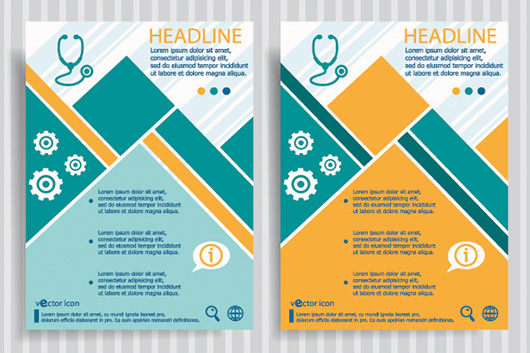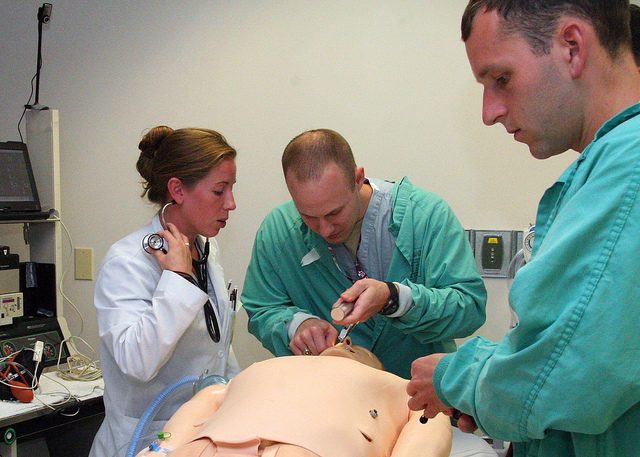
If you’re considering creating a new brochure for your medical practice or clinic, read on. Here are some common mistakes healthcare professionals make when putting together this important piece of marketing material, combined with a few useful tips on how to get it right.
If there’s one thing you need to do in marketing it’s research. Unfortunately, in the interests of saving time, it often gets overlooked by medical practitioners keen to get some physical collateral into the hands of prospective patients. Mistake one. If you don’t know your market or audience, your brochure won’t perform.
So what do you need to do? Seek out competitor brochures; Google search design trends and look at your patient stats for demographic insights.
All too often doctors create a brochure for their practice because it’s expected. However, without a clear reason for producing one, it can be a wasted exercise. Objectives are vital as they help guide your content, inform your distribution strategy and help you measure effectiveness.
There are many objectives you could set for your brochure: attracting new patients, building your brand and reputation; generating patient referrals; selling additional services. Likely it will be a combination of several. Whatever they are, make sure they align with your overall marketing plan.
With limited budgets to work with, doctors often turn to online templates in the hope of creating a brochure in house. Whilst this may be an option if you have staff who are adequately skilled, in most instances it should be avoided.
A DIY brochure, no matter how polished, still looks DIY. What kind of impression are you giving to prospective patients if you can’t pay out for a professionally designed, written and printed brochure on decent quality stock? Whilst it may cost you upfront it’s affordable, and entrusting your brochure to the experts will be money well spent.
When you’re delivering medical care, it’s easy to adopt a clinical tone in your brochure. In an attempt to inform patients about what your practice offers, describing your medical services, treatments and costs seems the natural way to go. Unfortunately it isn’t the right way to go.
To win patients over, you need to be forming emotional attachments not just filling them with information. As well as demonstrating an understanding of their situation, focus on benefits above features. In addition, keep your copy and images human, showcasing your people and your stories.
From an overcrowded design with minimal white space to blocks of unbroken text or pages that don’t flow logically from one to the next, creating a brochure which fails to take readability into account is a common mistake.
The most important thing to bear in mind is that people don’t read they scan. This means that you need to make your headings impactful and break up your text with subheads and bullets. In addition, support visuals with captions and ensure you tell a story from front to back.
When creating a brochure for their medical practice, many doctors turn to online stock photography to add visual appeal. It’s understandable. It’s convenient, can be inexpensive and saves you the time of setting up a shoot yourself. However, using it is not recommended.
Whilst stock images can look professional, they lack credibility. Why does that matter? Because without credibility you can’t build trust – a vital element in ensuring a patient chooses you over another practice. Using professional shots of your practice and staff will help you form those bonds and set you apart.
As well as avoiding these common mistakes, ensure your brochure has clear calls to action throughout so people know what to do next. Plus create a digital version – a simple PDF should suffice – so it can also be accessed online.

Selecting the right web design agency for your medical practice or healthcare clinic is critical to your online success. If they don’t offer an adequate level of expertise or people and processes you gel with, you could end up pouring time and money into a project that just won’t hit your objectives – whether that’s attracting new patients, keeping existing ones informed, or both.
Before you even start asking questions, you should be focused on finding agencies that not only design websites but which cater specifically for the medical web design market. Why? Because digital marketing in the healthcare sector requires specialised industry knowledge.
Once you’ve narrowed down your list of contenders, here are the top ten questions you should be asking before you make that hire.
It’s important to establish first off whether they do exactly what you’re looking for. Obviously they design websites but how far does their expertise extend? Are they limited to template designs or do they do custom-built? Do they offer responsive sites as standard? Can they set up an online booking system?
In addition, find out what services they offer besides fundamental web design – from copywriting to SEO optimisation, logo design and web hosting. Having it all done by the same company will certainly make life easier, but be sure to check the level of skill in each area.
Knowing how much your website will cost all up and how you’ll be billed is vital. Many web design agencies offer a total price for the finished project whilst others may charge by the hour.
If you’re offered a set price, ask for a breakdown so you know exactly how it’s calculated and what’s included. Many agencies offer packages which include a range of additional services. Ultimately, you want to be clear that no hidden costs will pop up along the way or once the site is completed.
You’d be crazy to start working with an agency without concrete evidence that they can deliver what they say they can. Any agency of substance should have a portfolio of work they’re more than happy to share with you – including live websites you can explore – ideally in the medical or healthcare sector.
But while a portfolio can prove design and development ability, you need more than this to make a decision. Ask for case studies of projects they have worked on, and look for statistical information on how their websites perform. And don’t forget to ask for references from previous clients so you can get a feel not only for the quality of their work but also a sense of what they’re like to work with.
It’s likely you’ll already have an idea about how soon you’d like your website up and running, therefore it’s important to find out the approximate turnaround time of your project. Four to six weeks is average for a build, but this can vary considerably depending on the agency, plus you should factor in more time for planning.
Being clear on the process is also important. As well as requesting a rundown of the basic workflow, be sure to prompt for further information about the initial consultation, the level of research carried out, who will be involved at each stage and how much involvement will be required from you.
As well as stating your needs and requirements, it’s likely you’ll have to provide a number of other items before your web design can get underway. This can include things such as background information on your medical or healthcare practice or clinic, logo files, copy, images and existing marketing collateral such as brochures.
The reason you need to ask this question is so you know how much time you will need to allocate to the project and, more importantly, to help establish expectations from the start.
If an agency has sufficiently consulted with you throughout the process, there should be little discrepancy between what you had hoped for and the final website design you receive. However, it pays to know upfront what the process would be if this situation occurred.
Most agencies will include a number of rounds of revision within their initial pricing, so minor tweaks and changes should be fine. If, however, the whole concept and delivery is not as expected you should be well within your rights to question why it isn’t.
There are three main elements to getting a website up and running: creating a design, registering a domain and setting up hosting. Importantly, ownership of each of these elements is not a given just because you’ve paid an agency to create your site – so find out from the start what the status quo is.
Often you will own the HTML/CCS/Javacript – the building blocks of your site – as well as the visual design. However, some agencies may choose to retain ownership and simply hand the licence over to you. Your domain is either registered to you or the agency and they may or may not manage your hosting.
As well as understanding everything that is involved in getting your website up and running, you also need to know on what happens after it goes live. As any half-decent digital marketer knows that creating a website and then leaving it to do its magic just won’t do. Instead you need to be constantly checking, updating and adding new content.
In some cases changes may have to go through the agency at a cost – unless you have the technical knowhow to revise the coding. Alternatively, a content management system (CCS) enables you to easily make changes via a select and click interface. Ask whether this is something they can provide.
As well as keeping your content fresh, your practice or clinic website should be regularly monitored and updated to ensure all the technical aspects are working efficiently. Carrying out plug-ins checks; doing backups; fixing errors with hosting and servers; making enhancements to useability; performing upgrades; these are all things you need to consider.
Knowing whether or not the agency you are speaking with offers these services is important as if they don’t you’ll need to start thinking how you plan to do it.
Last but not least, it’s important you know who you need to contact if you have a question, suggestion or issue at any stage of the process. Depending on the agency, you could be dealing predominately with the designer, or you might be given a project manager who will be responsible for communicating your message to the relevant person.
Whoever it is, be sure you have a name, relevant contact details and know when the best times are to contact them.
When asking these questions, remember there’s no right or wrong. You’re just trying to establish whether or not this particular web design agency is a credible, working fit for your medical practice or clinic.

Healthcare has been a notoriously slow adopter of digital trends. But today, medical professionals understand the importance of keeping up in this tech-savvy age. As well as improving their level of efficiency with practice management systems, most medical providers now have a business website to promote their services.
However, whilst many have a website, not all are utilizing it to its full potential. Yes, as a digital promotional tool it should effectively showcase your team, your services and your products. But why stop there? Your website can also function to enhance your service offering. By using digital tools to help meet patient needs you can improve their experience and streamline your business.
According to a 2014 survey by global research experts McKinsey, patients around the world have grown more comfortable with using digital networks and services when it comes to healthcare. In fact, 75% of respondents were happy to use digital healthcare services.
In addition, out of all the digital channels available, a website topped the patient channel preferences across all age groups. So, if patients are embracing online services, as a healthcare provider it’s time to be thinking about how you can make your website work harder.
To stay one step ahead, your website should not just do your marketing, it should also be a practical business tool through which you can better deliver your service and satisfy patient needs. Being innovative in terms of employing the latest flashy website features is not important in healthcare. What is important is including features that will offer added-value to patients, and your practice or clinic.
According to the same McKinsey survey, patient’s expectations when it comes to healthcare are rather basic: efficiency, better access to information, integration with other channels and the availability of a real person if the digital service doesn’t offer them what they need. Therefore, focusing your website efforts into delivering on these fundamental needs can be extremely effective.
To make your website an effective service delivery tool, it should not be viewed solely as a one-way communication channel for promotional ends.
Across the healthcare industry, patients, clinicians and providers alike are realising the benefits of turning website into a go-to platform for health information specific to their field. Including quality content and useful resources can be a great way to help you deliver on the patient need for better access to information. This can be done by including some of the following on your site:
Making your website a valuable source of information can be a great way to attract and retain patients. But by including interactive features and turning it into a two way communication portal, through which you and your patients can exchange information efficiently, you can gain that competitive edge. Here are two ways which are both simple and effective.
Online forms can be added to your website using code and can be easily customized. By allowing patients to access forms before they arrive at your clinic you can save time for both your patients and staff. The types of forms you could consider including are:
Patients expect confidentiality so ensure all your forms are secure. You could also include patient satisfaction surveys to allow patients to give feedback.
By giving patients to power to book their own appointments, you are offering patients an efficient way to access your service, and lessening the endless stream of phone calls. Many in practice management systems, such as Cliniko, have a real-time appointment booking feature which you can easily embed into your website.
You can also set up online booking using specialist software such as Ozdocsonline and HealthEngine. As well as integrating with your practice management systems they can be added to your website quickly and efficiently using a web plug-in.
The key to a successful healthcare website today and in the future is ensuring it meets the changing needs of patients. Non-digital channels, such as phone calls and face-to-face consultations, will continue to be important in healthcare. But by leveraging the power of digital and using your website to better deliver your service and not just as a marketing channel, your business can really benefit.

For healthcare providers looking to grow their conversions, landing pages present a great opportunity. Unfortunately, they are not utilised enough. Many medical businesses that promote themselves online often direct targeted traffic straight to their website homepage rather than sending them to the information they are looking for. This is where landing pages come in.
But what exactly is a landing page? What are the essential elements needed to create a successful one? And how you can use them to grow your clinic or practice?
A landing page is a standalone web page that is extremely targeted and has one conversion goal in mind. It sits at the end of an online advert, email marketing campaign or keyword search and should deliver on the promise of the link.
Whilst the aim of your website is to promote and inform a general audience on your services as a whole, a landing page should focus on a particular service, target a specific patient need and work hard at persuading them to take a particular action e.g. give contact details, book a consultation.
Before you begin putting together a landing page, you need to have one clear business objective in mind. For example, perhaps you want to increase the number of enquiries you get, generate more leads or increase profits by X in 6 months. Whatever it is, your conversion goal and your business objective should focus your content.
Landing pages should have two key elements: great copy and professional design. Each of these should work together to help you achieve your end goal.
When it comes to landing page copy, you should keep it clear, concise and take potential patients from A to B without distraction.
When creating your landing page always bear in mind the questions potential patients will have such as “Why should I trust you?”, “Do your offer the right service for me?’’, ‘’How can I access your service?”
Landing page design should be clean and uncluttered – it needs to let the words do the talking. Use a similar design to your website for branding purposes, but simplify it.
Finally, be sure to optimise your medical landing page for search by using the right keywords and other effective SEO tactics.
Most landing pages won’t be perfect first time around. Generally they will need monitoring and tweaking before they achieve maximum results. The best way to successfully optimise them is by A/B testing. Do a couple of versions, see which works best and use the results to amend your content and design to better meet your goals.

Branding is often overlooked when it comes to medical marketing. In fact, it wasn’t always necessary. However, building a strong brand for your healthcare practice or clinic is essential in today’s competitive healthcare market.
Without branding you are missing out on an opportunity to stand out from your competitors and connect with your patients. But knowing where to apply your efforts is the key to success?
Healthcare providers used to rely on their authority to attract patients. However, due to changes in the market, customer expectations and leaps in technology, medical services have needed to become increasingly customer-centric. Because of this, it is providers who best demonstrate their unique human value as well as their expertise, who are the ones attracting most patients.
And how do they demonstrate it? Through branding.
It is important to make a distinction between brand and branding.
Your brand is both the personality and the perceived value of your company. It is best described as a promise that tells people who you are and what they can expect from you. It is usually expressed by a series of attributes that connect at an emotional level. BUPA, for example, defines its brand as passionate, caring, authentic, accountable, open, courageous and extraordinary.
Branding on the other hand is the activities you undertake to build this brand perception. It includes not only your visual identity – your logo, website, brochure etc. but also your pricing, your premises and how you interact with your patients. Your brand should shine through in everything you do.
When done effectively, branding can help you:
Once you have your brand clearly defined, you can begin branding, or building your brand. But what are the key elements of branding you need to consider?
To be effective, your healthcare branding efforts must be being unique, memorable, consistent and consumer-centric. Although it might start with your logo, and a great logo is critical to branding success, your brand must infiltrate everything you do. If what you say is what you deliver, you will gain the trust of your patients – vital in healthcare today.

Whilst interpreter services in Australia are highly accessible, and have been shown to improve the quality and safety of health and medical care, the same consideration is not always paid to digital channels of communication. Yet producing content, such as websites, in different languages can benefit both service provider and patient – and the process is relatively straightforward.
Non-English speaking patients are par for the course for doctors and health practitioners in multicultural countries. There are very few who haven’t had to communicate across a language barrier – whether in promoting their service, attempting to understand symptoms or explaining to a patient what care they need. Creating a multicultural website is simply the next step.
For a provider practising in an area with a high Chinese population it makes sense to offer information in Mandarin or Cantonese. The same goes whatever nationality is relevant.
Not only can multilingual content lead to more appointments and enquiries but it also fulfils your obligation to provide patients with the information they need to make informed choices and give informed consent. It also helps build trust in your service.
If you are a private clinic offering specialist services or procedures, such as a cosmetic surgeon or a fertility clinic, you might also be looking to attract overseas clients. In these cases, a multilingual website will make you much more accessible and legitimate to a foreign market.
Research shows that if information in their own language is not easily accessible to consumers, the majority won’t buy. The same applies to medical services to an even greater degree because it is their health in question.
One of the reasons why health practitioners don’t offer other language versions of their website is often due to hesitation over how to effectively implement and manage it. But with the right assistance, the process can be relatively straightforward.
Before you begin, the first step is to go through your current website and decide which content you are going to translate. If you want a complete translation you need to include every element including:
When translating your web content you have two main options:
1. Utilize an online translation tool such as Google Translate
Online translation tools can be timely and cost effective. However, they present a big drawback. By making a literal translation they can miss out or misinterpret key words and meanings.
According to a study by the BMJ, Google Translate has only 57.7% accuracy when used for medical phrase translations. This could have negative consequences if a non-native patient misunderstands a service or what it entails.
2. Hire in the services of a professional medical translator
This is the recommended option. By hiring a qualified translator, which specific medical expertise, you can be more confident that the content will be accurate.
If you want to go one step further, you could also look to localise your site. Consider the format, layout and images – do they match the cultural expectations of your non-native English speaking patients? Do some research. If they don’t, change them.
Unless you have technical knowledge or a simple CMS system in place, enlisting the help of a digital specialist is recommended to get your new multilingual content up and running. They can input the content and set up all the links and code correctly to ensure your site runs smoothly.
One of the best ways to add and manage the new content is by using easy-to-identify links to other languages on the homepage of your current English site.
A multilingual site will set you apart as a medical service provider. It will also give your patients and clients confidence in your services and ensure they have all the information they need to make important choices.

When selecting images for your website, stock photography is often the easiest and most feasible option. Not only is it readily available, but it also offers a professional finish that looks good online. However, although stock images may be appealing, it’s worth thinking twice before using them. Instead of helping your business, this type of content has the potential to put-off prospective patients.
Stock imagery is widely used for medical marketing and advertising purposes, with online sites – such as Getty, Shutterstock and 500px – offering an extensive range of high-quality photographs. Two kinds of stock images are available: royalty-free (almost unlimited use of a photo) and rights-managed (one time use of a photo under a specific license).
When creating a medical website you can access literally thousands of professional-looking images, from doctors and patients to facilities and procedures. Digital databases make them easy to search through and when you find an image you like you can download and upload it instantly.
With such images at your fingertips, why spend valuable time or resources arranging a photoshoot, or relying on your own camera skills or those of your team?
Stock photos may appear to be the great solution, but they lack one very important thing: credibility. Although they are depicting real people and situations, they are not real. This matters, especially in the medical world where demonstrating integrity and building trust are vital components in attracting and retaining patients.
To build trust you need authenticity. Yes, a well-composed stock shot of a smiling doctor and patient may appear to get your point across, but it adds little value to your overall message that you are a genuine, credible service provider. In fact, it can actually create a negative impression with the stylised finish overriding believability.
Potential and existing customers are not fooled by slick, inauthentic photos which show nothing of who you really are. They want to see the human side of your business. They want to see the actual doctors who will be treating them, the kinds of premises you work from and, if relevant, for example for a cosmetic surgery provider, before and after treatment shots.
By using real images you can humanize your service. You can help people establish an emotional connection with your brand which results in greater trust and, ultimately, more appointments. For this reason, taking your own photos, rather than downloading stock images, can be worth the effort – but it must be done right.
Unless you have the creative and technical know-how, taking your own photos for your website is not recommended for medical industry content. Whilst amateur may work well for your social media accounts, on a website they can appear low quality and unprofessional. Instead, it is worth employing a photographer to take the photos for you – just check your staff are comfortable with this before you go ahead.
Not only will a professional ensure the lighting and composition is right, but they can also assist you in developing a visual story that is consistent with your brand and values. This way, you get images that are authentic and unique, but polished. To do this you must be prepared to invest and to update photos when staff come and go, but the end result is often worth it.
In an ideal world, using your own professionally taken photographs on your website is the best way to go. However, sometimes time or money constraints can make stock photos the most viable option for all or part of your content.
If you are looking at using stock, be sure to use quality sites, choose images that complement your content and service values and avoid overly staged or posed shots. And, importantly, pay attention to the copyright licences and who else is using the image – the more it is used, the less effective your SEO efforts. A good graphic designer can guide you through the process.
Images may speak a thousand words, but what those words are matter – so make your website images a priority.
Having a professional website for your practice is critical in today’s digital world. But unless you are actively promoting it, prospective patients won’t find it. And if they can’t find it, they don’t know who you are, what you offer or how to contact you. Tactics such as SEO are essential, but they take time. In the meantime, PPC offers a very feasible solution.

PPC or Pay-per-click is a form of internet marketing used to drive traffic to websites. In contrast to the traditional advertising model where you pay money every time your campaign appears on a site, in PPC you only pay when someone clicks on your advert.
Search engine advertising is one of the most popular forms of PPC. Search lets you advertise your practice next to or above the organic results on a search engine page, such as Google, Bing or Yahoo, as a sponsored link. Google Adwords is the most popular PPC publisher. However, it is also now an option on social media sites such as Facebook and LinkedIn.
With most PPC publishers, how much you pay per click depends on how much you ‘bid’. By bidding you are choosing the maximum amount you want to pay for each of the keywords or keyword phrases people are most likely to use to search for your practice. E.g. doctor’s surgery, late night appointments, central Sydney.
If your objective is to attract more patients to your practice, PPC certainly offers many advantages.
When executed correctly, PPC advertising can be very effective. Unfortunately, most people are not equipped with the know-how to get the very best out of it.
As well as having an understanding of how PPC publishing systems, such as Google Adwords, work, you also need to have keen knowledge of what works PPC wise in your industry. That is why it often pays to seek professional help.
Here are some pointers to get started:
PPC offers many benefits but it should be viewed as a short term strategy – one to boast patient numbers over a limited period of time – not a complete marketing strategy. For the best results it should be used alongside other tactics such as SEO and your client email marketing campaign.
In the previous article, we focused on human computer interfaces and how these have changed the way man and machine coexist together. As well as content strategy and how expertly crafted content can provide your business with high impact visibility. And finally how the new relationship management means that your medical business can have unprecedented connectivity with patients and clients, and to help them and build relationships in new ways.
In this second part, we will be looking at how smart phones have become a medical ‘brains trust’ that has revolutionised how patients record their healthcare data for analysis. We will also look at the ever increasing importance of privacy in healthcare in the age of the internet.
Smartphones are another form of technology that has become ubiquitous in our everyday lives. Although for all the technological advancement, we have only really touched the tip of the iceberg in terms of potential for patient-doctor interaction. Increased processing power, internal memory, bigger bandwidth and increasingly sophisticated devices mean that smartphones can take centre stage in providing patient-centric, outcome-driven healthcare. Not only can various apps be used as diagnostic tools or tracking devices for medical practitioners, but they can also be used to track wellness. Some apps are ‘prescription’ apps, that are recommended by doctors to patients and provide wellness information. This can be an important part of ongoing healthcare monitoring.
With more and more patients interacting and leaving an information footprint online, this necessitates a much more stronger control over client information. Electronic healthcare records that are stored on cloud servers or online are vulnerable to hacking by nefarious parties. The importance of healthcare privacy for this online information cannot be overstated.
Although it seems that clients want it both ways. They want to have easy access to their medical information and targeted help online, while also having the added assurance of impeccable privacy measures at the same time. This is the inherent tension that arises for healthcare businesses with the storage of healthcare information online. There is also concerns by government about the tracking of metadata and whether or not this is being used in the patients’ interests.
In the future it’s hoped that online privacy will become a well-governed, controlled and yet accessible system that will be amenable and offer patient-centric care. Along with this, medical businesses can use this data to offer targeted and relevant healthcare offerings.
Social media marketing has historically been overlooked by conservative healthcare businesses as being irrelevant or too time consuming. Although there is a place for it, if you would like to engage with potential new clients online. And if you don’t – the next medical practice around the corner certainly will.
Creating a niche, friendly and approachable online presence may fly in the face of many serious medical practices but this is precisely what patients want. They would like to engage with healthcare businesses online before they engage them in the real world. Or they occasionally want to reserve an appointment or ask a general inquiries question. Having this social media presence allows for other avenues so that patients can get to you.
Video has always been a favoured medium for expressing complex medical ideas in a fast, simple and easy to digest format for patients. Although with the birth of YouTube, video has become a gigantic part of online marketing for healthcare. Currently, Alexa web information rates YouTube as the third most visited site in the world. This is only topped by Google and Facebook. Along with this, Netflix makes up a significant portion of internet traffic in the US. People enjoy watching video for entertainment but also to stay informed about important issues that mean something to them – such as their health.
Video is a vital tool for healthcare marketing that has visual and aural impact as well as tells a story. It can be cross-platform, multi-device and portable. Although you must ensure that the videos are provided in the right context, to the right audience, using the right platform.

As EOFY approaches, now is a fantastic time for a rethink of your marketing outlook and prospects for growth. If you would like some more information on how to grow your healthcare business with a savvy online marketing strategy, speak with Total Medical Design today.
Technology is rapidly accelerating and changing beyond all recognition every few years. So the healthcare industry mustn’t only keep up, it must be at the forefront of these changes.
Doctors and medical practitioners everywhere would do well to stay on the pulse of these changes. So here’s everything you need to know about technology for marketing purposes in 2014 and beyond. It will help you to inform, persuade and inspire your key constituents.
For more information on comprehensive healthcare marketing strategies that encompass cutting edge technological changes, speak with Total Medical Design today.
The beloved and ubiquitous iPad has actually only been around since 2010. This was closely followed by the iPad 2, 3, 3.5, mini and so on. These touch screen devices were enormously popular. This was mirrored by the equally successful Windows 8 devices. The keyboard and mouse have become a nearly extinct add-on feature. Although they don’t look like becoming redundant anytime soon. Human-computer interfaces are the latest thing with natural and realistic integrated computers that blend the digital and real world in ever more interesting ways. Think of Google’s Project Glass, Apple’s Siri and MIT’s Project Oxygen.
This means that in healthcare, there are ever more sophisticated ways to record and store data and diagnose conditions through these intuitive interfaces. This type of technology is important for biometric sensors, geotracking and collecting patient data within a fully connected home.
Although not strictly considered a technology, content strategy is vital for any healthcare organisation. It’s more like a seismic shift in healthcare marketing. For GPs and medical practitioners, content can make your business a lot more viable, valuable and visible to an online audience. The rise of content marketing is demonstrated when we look at data from Google. Research conducted showed that consumers needed on average 5.3 sources of information prior ot making a purchase in 2010. This doubled in 2011 and tripled by 2012.
The art and science of creating, managing and distributing content through cross-channel methods is going to be a big linchpin for medical businesses in 2014 and beyond. If you haven’t already initiated a comprehensive content marketing strategy, then you should get on board right away.
In terms of healthcare, there is still a conservative approach to engaging with patients and potential clients online. There are now roles created specifically for creating, managing and strategising about online content. It doesn’t need to be slow and expensive, instead it can be dynamic, targeted and effective.
In the age of ubiquitous connectivity, there has become a much more urgent need to be genuine and form sustaining and long term relationships with clients. Furthermore to build a customer experience rather than simply a treatment or healthcare transaction between a doctor and patient. Although in 2014 and beyond, the movement towards meaningful engagement has become ever more prominent.
There are enormous cross-channel possibilities. Not to sell to your patients, but to inform them and provide them with treatment options and vital information that they need to make the right decisions for themselves. Although do remember that any meaningful communication should be relevant, timely, personal and genuinely valuable to them and not just to your business.
This type of relationship management that can take place in both the online and offline world will revolutionise health and wellness. It can be an important avenue for customer support and information. This can be especially valuable for chronic or serious conditions that require ongoing support and interaction.
Always remember that it’s vital to balance both customer privacy and the necessity to distribute targeted healthcare information.
The end of financial year is a brilliant time to think about reorganising and shifting focus in your healthcare business towards a much more dynamic and lean marketing strategy. For all of your healthcare marketing needs, Total Medical Design have you covered. Call us, we are here for you and can create a targeted and engaging healthcare marketing strategy to get the new financial year starting on a high note.
You’re probably used to best practice procedure is your field! Did you know that the same applies to medical website design? For every single exceptional medical website – there are a dozen drab, dull and confusing doctors’ websites!

GP’s and specialist medical practitioners in Australia rarely have time to sit down and ponder their online marketing strategy. Likewise their admin staff are completely run off their feet. However it’s vital to consider that the vast majority of Australians spend a significant amount of time online. In order to stay competitive it’s vital to have strong marketing assets.
Online marketing directs patients in much the same way as word-of-mouth marketing. Except that a well-designed website is far more attuned to the modern world. Here are some essentials for a top-notch medical or healthcare website.
1. It’s an Educational Opportunity
Many medical consulting practices view marketing and healthcare as strange bedfellows. They needn’t be such polar opposites though! A website can be both a marketing tool for a medical practice, while also being educational; providing timely, relevant information to patients.
A blog with freshly updated content about your practice,can be an invaluable part of your practice!
This can include targeted information sent to patients who need it, who can read it at their own leisure.
2. Aim for Clarity, Simplicity and Honesty
Your message should be conveyed in the most simple and clear manner through words, imagery and design. This will build trust with potential clients. Remember that good websites are primarily about the end-user and making the website or other asset as easy to use as possible.
3. It’s Not About You, It’s About the User
This word ‘usability’ is bandied about constantly in marketing circles. Basically it refers to how easy your patients find the information that they are after. The end-user of the site should be able to go onto your website and not have to think about how to use it – the website should intuitive and flow logically, following well-known design conventions. Users have an expectation that a website should be this way. When it isn’t, they will leave in an instant!
User-experience is a complicated part of web design but in essence it involves elements like information architecture, site maps, colours, typography, images and content. All of these gel together so that the person browsing the site gets what they need with as minimal effort possible.

4. Content is the Key to the Online Kingdom
As a corollary to the previous points, it’s vital to have high quality content on all of your marketing assets. This may seem resource-intensive. Initially, you may not understand the point! However it’s good quality content that is a search engine’s best friend. It’s also great for human eyes to browse. No doubt you’ve unwittingly landed on a poor site yourself, leaving hastily because of poor content.
Content resonates with patients and with the broader Australian public and says ”Hey. Here we are. We are experts who clearly know what we’re talking about.” When compared to Pay Per Click Advertising, investing in great content is a longer route but ultimately more effective method for reputation building.
5. You’re Never Done: Test, Measure and Modify
The most important thing to remember is that a website is never complete, nor is it ever static and requires no tweaking. For a doctor’s website to remain be effective, it needs to be constantly updated with fresh content and then this content tested for usability. Website analytics provide in-depth insights into how pages, pieces of content and in-bound links are performing. Along with where your audience are located, what device they are using and how well particular pages are performing. In order to improve your relative positioning on search engines and improve your relevancy to the audience, analytics needs to play a part.
6. Take an Integrative Approach
It takes more than a website to get people to know about your doctor’s surgery. A website is a great start but it’s like being stranded on a desert island without a dingy. A website without any other help will not get noticed. Think of social media as a dingy or a passing freighter. This is the way to connect your site to where all of your patients are hanging out and killing time.
Pay Per Click advertising is another way to connect the dots. It provides instant visibility on search engines and drives targeted local traffic to your site using paid ads. Email marketing is another way to reach qualified and targeted audience members, who are interested in what you have to say. All of these tools are designed to complement each other and bolster each other’s effectiveness.
For a one-stop medical marketing agency that knows how to bring out the essence of your Aussie medical practice, speak with Total Medical Design today on 1300 767 441
The internet may as well come with a ‘toxic substance’ sign attached on it and flashing lights, for all that Australian medical practices care about it! There are plenty of medical practices in Australia that are simply left behind in the race for online visibility. They prefer the old-fashioned pamphlet and phone call mode of communication with patients and potential new patients. Although this is rapidly becoming outmoded. To ignore the internet and web-based communication is to severely undermine a seismic shift in society. Here are some ways to put the buzz back into your marketing efforts, while also maintaining your credibility and authority as a medical practice.
User experience in its simplest terms means how your audience interacts with your website. And also whether or not the audience finds the website easy and intuitive to use. Recent research by Econsultancy’s Australian User Report interviewed staff at 200 digital and ecommerce companies. 96% of these respondents thought that user experience was incredibly important for clients. However 16% of these people rated the performance of websites as poor and only 37% of them rated them as excellent.
What this means is that Aussie businesses have to make some radical changes to get their websites up to speed. Here are some basic changes that make all the difference to usability.
An easy to use online form
The online form should be easy to use. Leave out the annoying questions and keep the online form as simple as possible. Alternately you can make most fields optional. The pre-appointment questionnaire on your website shouldn’t be frustrating or long-winded for the end user. Save the lengthy form for when the new patient arrives at the practice and have to wait to see the doctor.
Prominent contact details and directions
This is an obvious one, however it’s surprising how many medical practice websites forget about the essentials, as they are waylaid with details about services and procedures. Make sure the telephone number and address are listed prominently on the website, alongside Google maps and directions via public transport and car.
Include a powerful call to action
Give visitors to the site a sense of direction by telling them what you want them to do. You want them to call, or to book an appointment or to send an email inquiry. So you should make this obvious.
Optimise for search engines
Optimise the website by using SEO keywords in the metatags and throughout the body text and titles. Consider implementing a Pay Per Click campaign in order to guarantee placement on popular search engines and to drive up click-throughs to the website.
There are of course, many more ways to optimise your website for user-experience. For more information, give us a call!
Telstra’s Smartphone Index indicates that Australia has one of the highest rates of smart phone ownership in the world. Second only to China and South Korea, 72% of Aussies have a smartphone. According to the same research, approximately 71% of these people access to the internet via their smartphone.
So that your medical practice doesn’t miss a trick, it’s important to incorporate a mobile website that is user-friendly and optimised for various platforms like iOS, Android and Windows. Also, geo-location tracking is a critical feature. This means that when people browse for a doctor’s surgery on their phone, they will be able to find you easily.
According to a recent report, 12 million Australians have an active account on Facebook. Although Facebook tends to take the lion’s share of captive audience, there are still other social media favourites. LinkedIn now has 3.7 million Australian users, Pinterest 1.7 million, and YouTube has over 11 million Australian users.
So where does this leave medical practices in terms of reaching new patients? Often in the dark unfortunately. The majority of Australian medical practices rely on antiquated methods of communicating with their patients.
Change is a good thing when it comes to social media though. It’s far more cost-effective than old methods of
marketing. It’s also far more personalised and friendly than traditional marketing. So make sure that you invest in a social media manager and integrate your social media efforts with your website. This investment will pay for itself many times over.
For the uninitiated, content marketing is the strategy of creating content (video, audio, text and more) that is distributed to your specific audience via various platforms (PC, mobile phone, tablet). It is created to appeal to your patients and potential new clients. Each piece of content ingeniously reflects your medical practice’s values, while also entertaining and educating your audience on topics of interest to them. It’s vitally important as this fosters brand recognition, and helps to build trust between your practice and patients.
Get premium support for your Australian medical practice with Total Medical Design today! We are the one-stop-shop for healthcare sector marketing.
Digital Marketing Lab; ”Australian Digital Statistics Compilation”;
http://digitalmarketinglab.com.au/index.php/2013/10/27/2013-australian-digital-statistics-compilation/ 27th October, 2013.